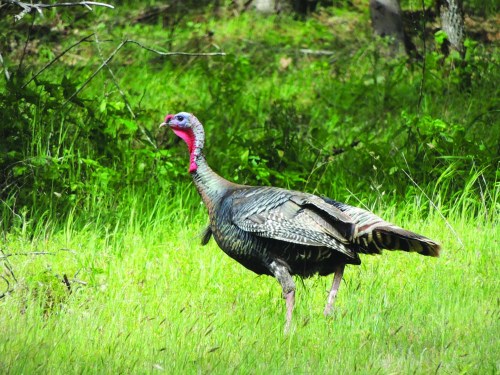On the trail: A greenhorn’s guide to spring turkey hunting
Published 7:00 am Saturday, April 10, 2021

- A young male turkey skulks along a tree line.
They were little more than six brown dots on a green landscape 800 yards away.
With the box call, I made quiet hen sounds while Jim watched with his binoculars.
“They’re listening,” he said.
One of turkeys stretched out his neck and gobbled. Then the turkeys started to move, high on the ridge. I doubted they would cross the wide open field between us this late in the morning.
We heard a hen on the ridge at the same level as the gobblers. If they ran into her, they’d probably hang up, but it was worth a try.
We jumped in the truck and motored one-half mile up the hill. Jim hid the truck and I walked down through the trees, set up the decoy and leaned back against a tree.
A little hen talk prompted the hen to start clucking again. Way out in the distance a gobbler answered. There had been six gobblers. There was one hen between us. This could work.
On the box call, I tried to mimic the sounds the hen made.
Soon the hen was quiet.
Rather than raise the volume, I called whisper-soft.
Fifteen minutes, five shiny toms came into view.
The grass was too tall to look at beards. As soon as the first bright red head cleared a fallen tree, I put the bead on it and squeezed the trigger.
It was 9:10 a.m. With that lonely hen’s help, I’d worked the flock for an hour and 20 minutes.
At first it seemed like the hen was my competitor for the toms’ attentions, but because there were more gobblers than females, her charms helped lure them into my trap.
If I had to guess, the boss gobbler got the girl. There’s no doubt his wingman got to be guest of honor at my table.
The good old days of turkey hunting
There has never been a better time to become a turkey hunter. Since the first introductions in the 1960s, turkeys — Rio Grandes and Merriams — have filled in prime habitat in every county in our state.
It isn’t difficult for a greenhorn to get started.
Start with a shotgun — preferably a 12-gauge or a 20. There are special chokes and camo patterns, but those can come later.
As to the care and feeding of the shotgun, No. 4s, 5s and 6s are good for turkeys. Pattern the gun with the selected load out to 40 yards. Start at 10 yards and work back to 50 yards, with a target about the size of a silver dollar.
Somewhere about 40 yards, the pattern will open up. The load ceases to be effective when there are less than six pellets in a turkey’s neck and head.
Many people don’t try turkey hunting because they don’t know how to call. But the turkey has a brain the size of a pea. It doesn’t take a genius to learn to call them. Watch a video or listen to turkeys talking, then mimic those sounds. Call softly, the quieter the better. Turkeys can hear at least three times as well as humans. In the spring, the gobbler is paying attention to what any hen has to say.
Calls are easy to master with practice. I like a box call because I can make it quiet and hen whispers bring gobblers from hundreds of yards.
Go camouflaged from head to toe, all the way out to the fingertips. The turkey might have a pea brain, but it is good at picking up movement and the flash of human skin. A face mask and gloves complete the costume.
There have been days when I have sat with my back to the same tree for four hours. A camo cushion helps. But this gets to the hardest part of turkey hunting — where do you put the cushion?
Top turkey units in Northeast Oregon
Four of the top 15 Oregon turkey units are in Northeast Oregon: Northside, Sled Springs, Heppner and Mount Emily.
Other good bets in Northeast Oregon include the Murderer’s Creek, Fossil, Sumpter, Wenaha and Keating units. Access can be easier because of the large amount of public land in the Wallowa-Whitman and Umatilla national forests.
Spring finds turkeys in the foothills, primarily on the south-facing slopes, but they begin to work their way up to higher elevations as the snow melts. According to the harvest statistics, it takes about 2½ days for the average hunter to tie a tag on a turkey. The season is long — April 15 to May 31 statewide — and there is a lot of time to make the statistics work in a hunter’s favor.





